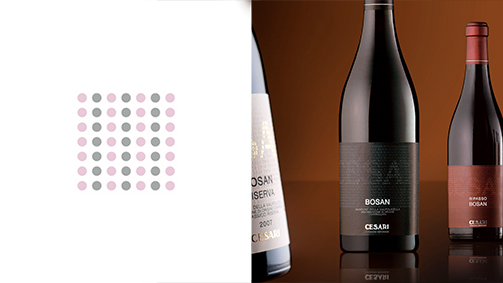Label Art: the laws of organization of visual information - Part 2
In the second part of Label Art, organised by the association “Gli Ergonauti” and Maria Teresa Tonutti, Paolo Bernardis, researcher in the field of visual perception and cognitive neuroscience at the University of Trieste, and Giacomo Bersanetti, designer and founder of SGA Wine Design, talk about the principles on which our perceptive system works before complex visual information.
When we recognise an object in a visual scene and give it a name, our brain has carried out a series of processes that allow it to establish that certain parts of the scene belong to the object while others belong to the background or other objects.
For example, in the famous image of the Dalmatian by the photographer R.C. James, it isn’t easy to distinguish which black marks are the dog and which are the background; and yet once the silhouette has been recognised it is impossible not to see it again.

Or in the image of the panda, the famous symbol of the WWF, where does the white of the head end and the white of the background begin?

And in Rubin’s paradigmatic vase, what object is depicted? The vase/candelabra or two heads facing each other?

Our perceptive system uses principles or rules (also known as laws of segregation/unification) to decide which parts of an image are part of the object and which are part of the background. These principles, described for the first time by the Gestalt school psychologist Max Wertheimer (1880-1943), can be summed up as follows: (a) principle of proximity, objects close together tend to be grouped into units; (b) principle of similarity, elements that look similar tend to be grouped into units; (c) principle of common fate, elements that move in unison tend to be grouped into units; (d) principle of objective set, united elements tend to maintain unity; (e) principle of good continuation, elements tend to be organised in groups that require the least variation in the perceived contours; (f) principle of closure, information is organised into elements that generate the perception of closed edges; (g) principle of past experience, the observer favours organisation of information influenced by previous knowledge.
These principles involve a ‘ceteris paribus’ (all other things being equal) clause; in other words, the factor in question will affect grouping between the elements only when other factors are equated between elements.
The validity of Wertheimer’s observations is confirmed by a great many subsequent observations, using probabilistic models (Kubovy, 1994). Most perception researchers today agree that Wertheimer’s laws work because they correspond to statistical regularities of the environment and the objects that populate it.
The relationships between art and science are well known and have can be traced back many centuries. We only need think of Leonardo da Vinci for example, and of his painting influenced by his study of anatomy and physiology. To cite an example from our times, a scientist particularly dear to me and who also painted, is Gaetano Kanizsa. Kanizsa was an internationally famous academic, founder of the Triestine school, and made fundamental contributions to the study of perception and the psychology of cognitive processes in general. “Kanizsa’s triangle”, invented in 1954, has become a universally recognised symbol of research into visual perception.
But Gaetano Kanizsa was also a surprising painter, and into his painting, not without irony, he poured his interest for the “creation” of images, as he had the chance to write when he participated at the 10th Biennial of San Martino di Lupari, 1990*. An app* dedicated to Kanizsa can be downloaded at the following link: https://itunes.apple.com/it/app/kanizsapp/id1038839202?l=en&mt=8
PAOLO BERNARDIS
Below are a selected examples of design projects inspired by Wertheimer’s laws of perceptual organisation.

Cesari - 2004

Michele Chiarlo - 2014

Cascina Castlet - 2008

Cesari - 2010
From the catalogue “Moltitudine di impronte” 2002, published by his daughter Silvia Kanizsa.
App created by Paolo Bernardis, Walter Gerbino, Carlo Fantoni, Studio trart and Provincia di Trieste


